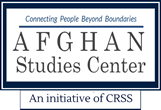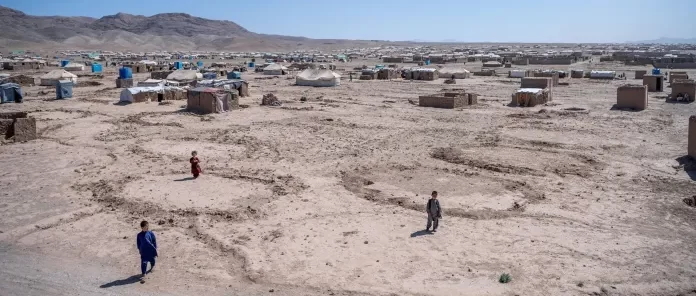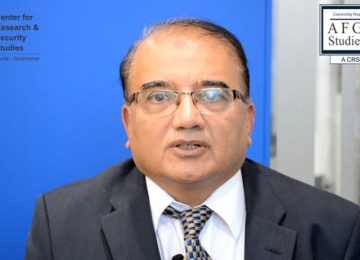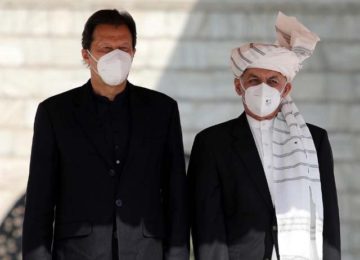By Elsa Imdad
Afghanistan, often associated with conflict and political instability, is facing a different yet equally devastating crisis: its extreme vulnerability to natural and climatic disasters. Ranked as the second most disaster-prone country in the world, only behind Haiti, Afghanistan’s susceptibility to hazards like floods, earthquakes, and droughts is exacerbated by climate change and environmental degradation. While global focus often centres on Afghanistan’s security challenges, its growing climate vulnerability presents an urgent and often overlooked threat to its stability and future.
A Nation at the Mercy of Nature
Out of every one million Afghans, 1,150 die each year due to various natural disasters. These figures reflect not only a tragic loss of life but also extensive economic damages that deepen poverty, especially in rural and vulnerable communities. While the human cost is heart-wrenching, the socioeconomic toll—destroyed infrastructure, displacement, and economic paralysis—amplifies the suffering. Poorer regions, already struggling with the basic necessities of life, experience twice the impact of natural disasters compared to wealthier areas.
Flooding: A Recurring Catastrophe
Flooding remains Afghanistan’s most frequent natural disaster, affecting over 100,000 people annually. Climate change, alongside population growth, is expected to increase this number drastically by 2050. Regions such as Kabul, Hairatan, and the Helmand Basin are particularly vulnerable to flooding due to their proximity to rivers, which are primarily fed by melting glaciers and seasonal snowmelt from mountain ranges.
Recent events illustrate the devastating impact of floods. In May 2024, severe flooding in eastern Afghanistan claimed 40 lives, injured 350 people, and displaced 1,500 children. With significant infrastructure damage in areas like Nangarhar and Kunar, the country faces an uphill battle in rebuilding.
Earthquakes: A Constant Threat
Afghanistan lies in a highly active seismic zone, positioned at the intersection of the Eurasian, Indian, and Arabian tectonic plates. Earthquakes are the deadliest natural hazard in the country, with millions of fatalities over the last century. The earthquake that struck in October 2023, with magnitudes ranging from 6.3 to 6.4, devastated the Herat, Badghis, and Farah provinces, killing nearly 1,500 people and displacing thousands more.
Earthquakes have caused the highest number of fatalities in the country, with almost 2.7 million deaths since 1900.
Droughts: An Invisible Killer
With more than 85% of Afghanistan’s population reliant on agriculture, droughts present an existential threat to both livelihoods and food security. As droughts intensify due to climate change, the Helmand Basin, a critical agricultural region, is expected to experience increased aridity. In early 2024, Afghanistan endured its worst drought in 30 years, affecting three-quarters of the country and threatening the livelihoods of over half its population.
Landslides: A Deadly Byproduct of Afghanistan’s Terrain
Afghanistan’s mountainous terrain makes it prone to landslides, particularly during periods of heavy rainfall or seismic activity. Population growth in mountainous regions is expected to double the number of people affected by landslides by 2050. One of the deadliest landslides in recent memory occurred in 2014, when heavy rains triggered a slope collapse in Ab Barak village, killing up to 2,000 people.
Avalanches: A Seasonal Menace
In the Hindu Kush region, avalanches are a seasonal hazard that poses a serious threat to communities, particularly in the northeastern and western provinces. Climate change is expected to increase avalanche risks in high-altitude areas, even as lower-lying regions might see a decrease in snow-related incidents. Avalanches in 2015 killed over 200 people, and the risk of similar disasters looms large every winter.
Strategies for Building Resilience
As the impacts of climate change worsen, it becomes clear that Afghanistan’s vulnerability to natural disasters will only increase unless significant efforts are made to bolster resilience.
There are several strategies that could help mitigate these risks. For example, projects like flood-retaining walls could provide significant economic protection. A flood embankment in Kabul is expected to prevent $600,000 in damages annually, while an investment of $180,000 in flood walls could save $13.5 million in future damages. Similarly, retrofitting public buildings to withstand earthquakes could reduce fatalities by 90% and economic losses by 60%, while improved water management and irrigation systems are vital for mitigating drought risks.
For landslides and avalanches, constructing barriers like boulder-gathering trenches, snow fences, and reinforced buildings are crucial to protecting communities. Monitoring high-risk areas and restricting development in these zones would help prevent catastrophic losses of life and property.
Proactive planning, early warning systems, and disaster education programs are also essential components of building a resilient Afghanistan. Empowering local communities with the tools and knowledge to respond effectively when disasters strike is a long-term investment that will save lives and reduce economic losses.
Conclusion
Climate vulnerability must not be dismissed as a secondary concern—it is Afghanistan’s next major challenge and calls for swift and sustained action. Without immediate intervention, the escalating impact of natural disasters could further destabilize the country, compounding its humanitarian and economic crises. Addressing this issue is not just a matter of survival but will be a critical step toward securing a resilient and sustainable future for Afghanistan.
AUTHOR

Elsa Imdad is a USG Alumna. She holds a bachelors in modern languages with an English major and Spanish minor. She has previously been part of American Spaces in Pakistan and now works as a Project Coordinator at the Center for Research and Security Studies. She is also a weekly contributor for Matrix. Her interests include public diplomacy, language teaching, peace and conflict resolution, capacity building for marginalized groups, etc.








